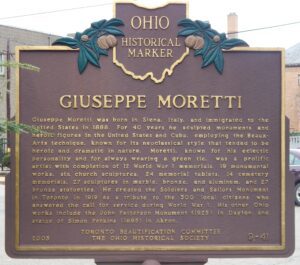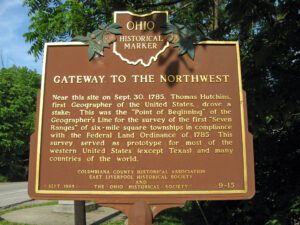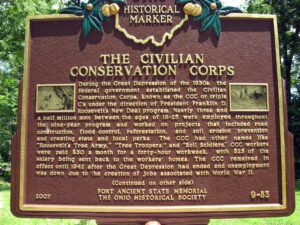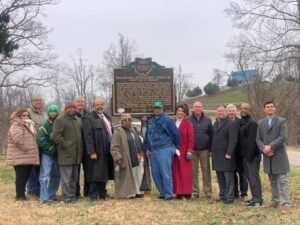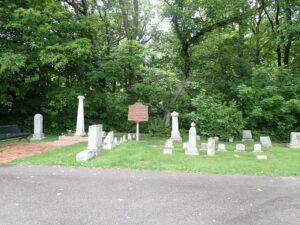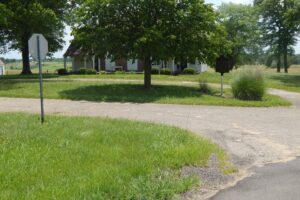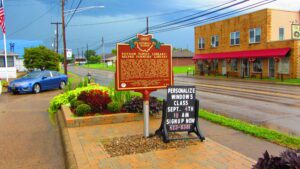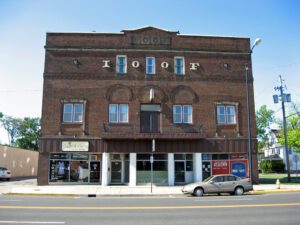, OH
Giuseppe Moretti was born in Siena, Italy, and immigrated to the United States in 1888. For 40 years he sculpted monuments and heroic figures in the United States and Cuba, employing the Beaux-Arts technique, known for its neoclassical style that tended to be heroic and dramatic in nature. Mor etti, known for his eclectic personality and for always wearing a green tie, was a prolific artist with completion of 12 World War I memorials, 19 monumental works, six church sculptures, 24 memorial tablets, 14 cemetery memorials, 27 sculptures in marble, bronze, and aluminum, and 27 bronze statuettes. He created the Soldiers and Sailors Monument in Toronto in 1919 as a tribute to the 300 local citizens who answered the call for service during World War I. His other Ohio works include the John Patterson Monument (1925) in Dayton and statue of Simon Perkins (1895) in Akron.
, OH
Near this site on Sept. 30, 1785, Thomas Hutchins, first Geographer of the United States, drove a stake: This was the “Point of Beginning” of the Geographer’s Line for the survey of the first “Seven Ranges” of six-mile square townships in compliance with the Federal Land Ordinance of 1785. This survey served as a prototype for most of the western United States (except Texas) and many countries of the world.
, OH
During the Great Depression of the 1930s, the federal government established the Civilian Conservation Corps, known as the CCC or triple C’s under the direction of President Franklin D. Roosevelt’s New Deal program. Nearly three and a half million men between the ages of 18-25 were employed throughout the nine-year program and worked on projects that included road construction, flood control, reforestation, and soil erosion prevention and creating state and local parks. The CCC had other names like “Roosevelt’s Tree Army,” “Tree Troopers,” and “Soil Soldiers.” CCC workers were paid $30 a month for a forty-hour workweek, with $25 of the salary being sent back to the workers’ homes. The CCC remained in effect until 1942 after the Great Depression had ended and unemployment was down due to the creation of jobs associated with World War II.
, OH
Macedonia Cemetery (circa 1840) belongs to Macedonia Church, Ohio’s first Black Church. Those buried include settlers of the Macedonia Free Black Settlement, built by free people who assisted freedom seekers along the Underground Railroad. Also interred are soldiers of the Civil War’s United States Colored Troops (USCT), most of whom served in the 5th Regiment, Ohio’s first Black Regiment (1863). The Polley family also rest here. Emancipated slaves, the family continued their freedom struggle when their children were kidnapped from Ohio and unlawfully sold into slavery. Macedonia’s extant burial grounds include this sacred site and another 1/2 mile north.
, OH
Song writer and minister of the United Brethren Church, Hanby was an Otterbein College graduate, class of 1858, known throughout the world for the inspiring songs, “Darling Nellie Gray,” “Up on the Housetop,” and “Who is He in Yonder Stall.” Hanby House in Westerville is maintained as a memorial honoring Benjamin and his father, Bishop William Hanby.
, OH
Agricultural development and cultivation on steep lands led to severe soil erosion in the nation in the 1920s and 1930s. In response, the United States Department of Agriculture established the Soil Conservation Service (SCS) in 1935. The SCS established the North Appalachian Experimental Watershed (NAEW) in the hills of Coshocton County to study and develop methods of conserving soil and water resources. The Federal government and Coshocton County purchased 1,047 acres of land for the program and, in 1936, field research equipment was installed and buildings constructed. The Works Progress Administration (WPA) and Civilian Conservation Corps (CCC) provided labor near the program’s inception, as did the Civilian Public Service Agency during World War II. (Continued on other side)
, OH
As a shareholder of the United Library Association in Pomfret, Connecticut, General Israel Putnam amassed a large collection of books, which was called the Putnam Family Library. The collection was divided among his heirs after his death in 1790. His son, Colonel Israel Putnam brought part of that collection with him to Washington County, Ohio, in 1795. Education was a foremost concern to settlers in the Ohio Country and was reinforced in article three of the Northwest Ordinance of 1787. Accordingly, the Putnam family’s collection circulated among neighbors and provided the means of education for the people of Belpre and surrounding communities. By 1796, a group of subscribers, paying ten dollars a share, fully organized a public library. Later known as the Belpre Farmers’ Library, it was the first library established in the Northwest Territory. The library operated under the management of the shareholders until 1815.
, OH
The Independent Order of Odd Fellows (IOOF), a world-wide fraternal organization, was introduced to the United States from England in 1819 and was established in Ohio in 1830. Mahoning Lodge #29 in Warren, Ohio, received its jurisdictional charter on May 21, 1844, and is currently the oldest active lodge in northeast Ohio. The lodge was originally located at the southwest corner of Park Avenue and Market Street, but was subsequently moved several times within the city. The present Odd Fellows Temple was dedicated in 1925. Friendship, Love, and Truth. Erected May 21, 1994, in commemoration of the 150th anniversary of Mahoning Lodge #29 in Warren, Ohio


